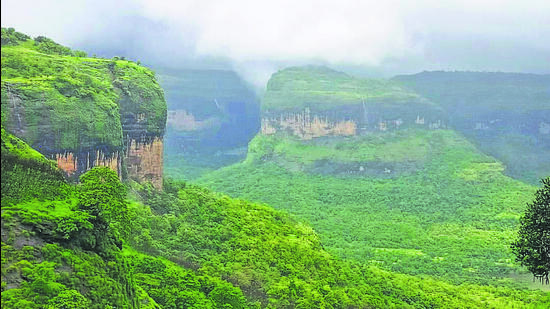Ecostani: Western Ghats, hill states lose forest; growth outside reserved forests
Forest laws have been diluted over the years resulting in loss of forest, especially the very dense and moderate forest areas.
The Forest Survey of India which provides an assessment of country’s green cover has recorded a decline in forest cover in eight Himalayan states over the period between 2021 and 2023 and a reduction in green cover in the Western Ghats over a 10-year period, the two most ecologically sensitive and pristine mountain areas of the country.

As per the report released on Saturday, the total forest and tree cover, which includes plantations, of the country is 8,27,356.95 sq km which is 25.17% of the geographical area of the country.
The current assessment shows an increase of 156.41 sq km in forest cover at national level as compared to the previous assessment in 2021. The total forest and tree cover of the country has increased by 1445.81 sq km during the same period. However, the increase in forest cover is primarily because of plantations as the study does not make any distinction based on the origin of tree crops (whether natural or manmade) or specific tree species.
The term “Forest Cover” in the ISFR, besides capturing natural forests, encompasses a wide range of tree species, including bamboo, fruit orchards, coconut, oil-palm, Subabul, Eucalyptus, Poplar, Acacia, Casuarina, Areca Nut, Rubber plantations, and shade-trees in Tea and Coffee plantations. Therefore, attributing the increase in the forest cover to the efforts of forest departments will not be correct. In fact, loss of natural forest and tree cover has been compensated with increase in area of plantations in states such as Tripura, Telangana, Madhya Pradesh and Kerala, the study found increase in the area of plantations whereas no change was reported from Goa.
While there is an increase in forest cover in very dense forests, India has lost forests in moderate and open forest areas, inside and outside reserve forest areas. Most very dense forest areas fall in protected areas with the highest level of monitoring whereas most of moderate and open forests do not have effective forest conservation mechanisms.
Forest cover in the hills districts of the country is 2,83,713.20 sq km, which is 40% of the total geographical area of these districts. In the current assessment, forest cover has in hill districts of the country increased by 234.14 sq km.
Despite the overall increase, Tripura has recorded the largest loss of 95.3 sq kms followed by Arunachal Pradesh of 91 sq km, Assam of 71 sq km, Manipur of 54.8 sq km, Nagaland of 51.9 sq km, Meghalaya of 30 sq km, Uttarakhand of 22.9 sq km and West Bengal of 2.4 sq km.
In Tripura, the report said, satellite imageries and field photographs show how large tracts of forest land have been converted into plantations. Around 11.90% of the state’s geographical area is rubber plantation covering all districts of Tripura. In Assam, decline in forest cover has been attributed to Jhum or shifting cultivation.
Most of the decline in forest cover is in protected areas such as Corbett National Park and Rajaji National Park in Uttarakhand.
However, Mizoram gained 241.7 sq km, Jammu and Kashmir 83.5 sq km and Himachal 54.7 sq km. In Himachal and Jammu and Kashmir, most of the gains in green cover were on account of plantations such as fruit orchards, which in many places are encroachment on forest land, and tea plantations.
The Western Ghats Eco-Sensitive Areas (WGESA) occupies an area of approximately 60,285.61 km2 based on the digital boundary provided by MoEF & CC. Forest cover in all districts under WGESA has been estimated as 44,043.99 km2 (73%).
The FSI has carried out a decadal changes analysis of forest cover of WGESA and observed that there has been an overall loss of 58.22 sq km in forest cover in the last 10 years. Very dense forest increased by 3,465.12 sq km, whereas moderately dense forest and open forest decreased by 1,043.23 sq km and 2,480.11 sq km. Majority of the districts in six Western Ghats states has witnessed decline on green cover.
Basically, the report indicates that the areas, which fall in the fringe of unprotected WGESA have witnessed a loss in the green cover. The Central government in 2010 started the process for identifying and declaring the Western Ghat Ecological Sensitive Area and earmarked about 33% of the Western Ghats as ESA.
The ESA is yet to be declared in 2024 as state governments are reluctant to notify the legally bounding ESA as it would impose some restrictions on people living in the region and for businesses running from there. “Not declaring ESA is the biggest ecological crime the government has done,” said Madhav Gadgil, who was the original author of the report on WGESA and was recently awarded Champions of the Earth, which is equivalent to Nobel Prize for environment.
As per forest policy of 1952 or Forest Conservation Act of 1980, forest in hill states should be 66% of geographical area and in other states it should be 33%. However, forest laws have been diluted over the years resulting in loss of forest, especially the very dense and moderate forest. The survey does not provide details of the forest loss due to developmental activities.
The Forest Survey report is a tedious exercise to map Indian forests every two years and tells us about the health of country’s forest. The report like previous versions has not indicated any improvement in the health of forests and there is a need to relook at forest conservation laws to provide the impetus needed to augment forest health.
All Access.
One Subscription.
Get 360° coverage—from daily headlines
to 100 year archives.



HT App & Website







